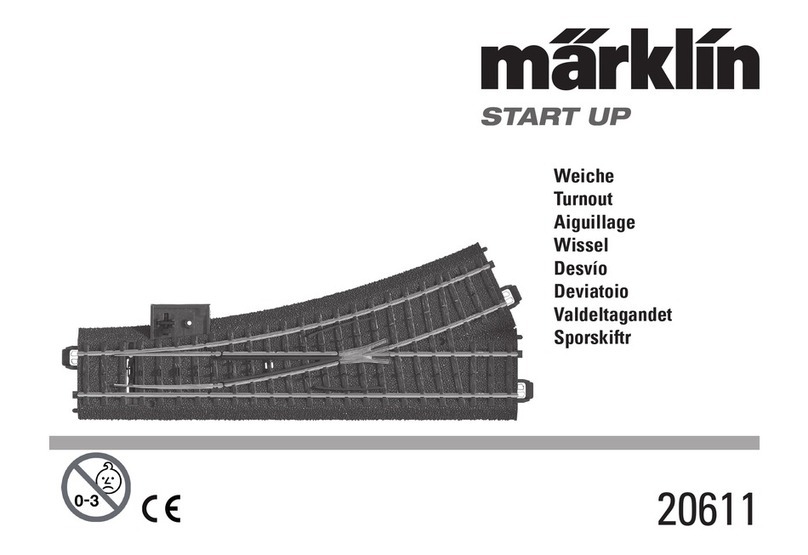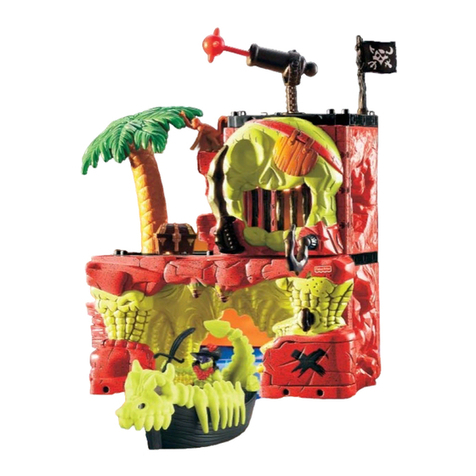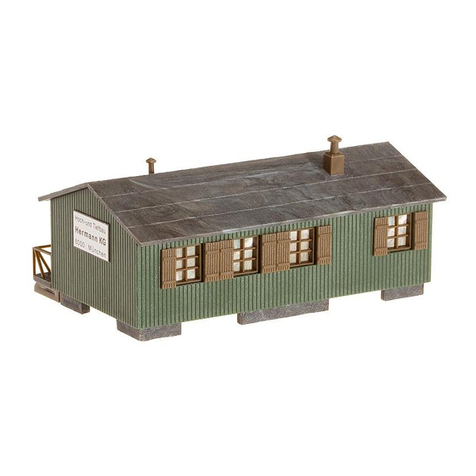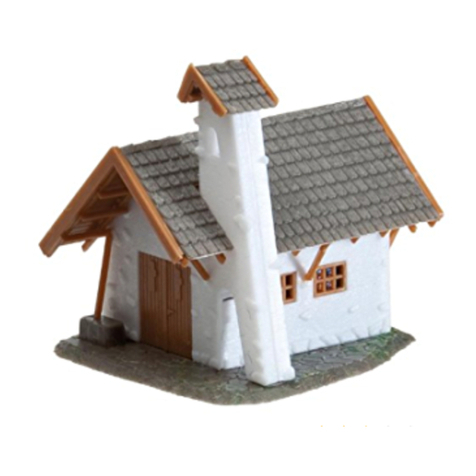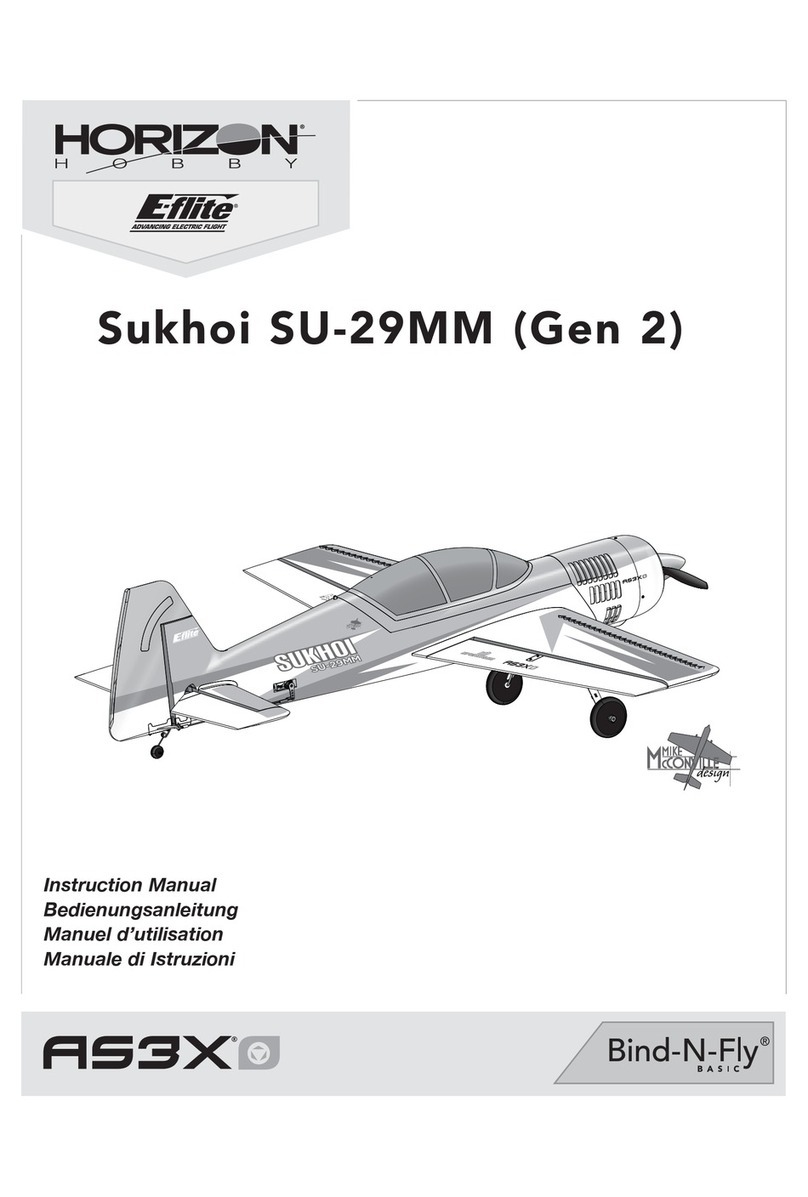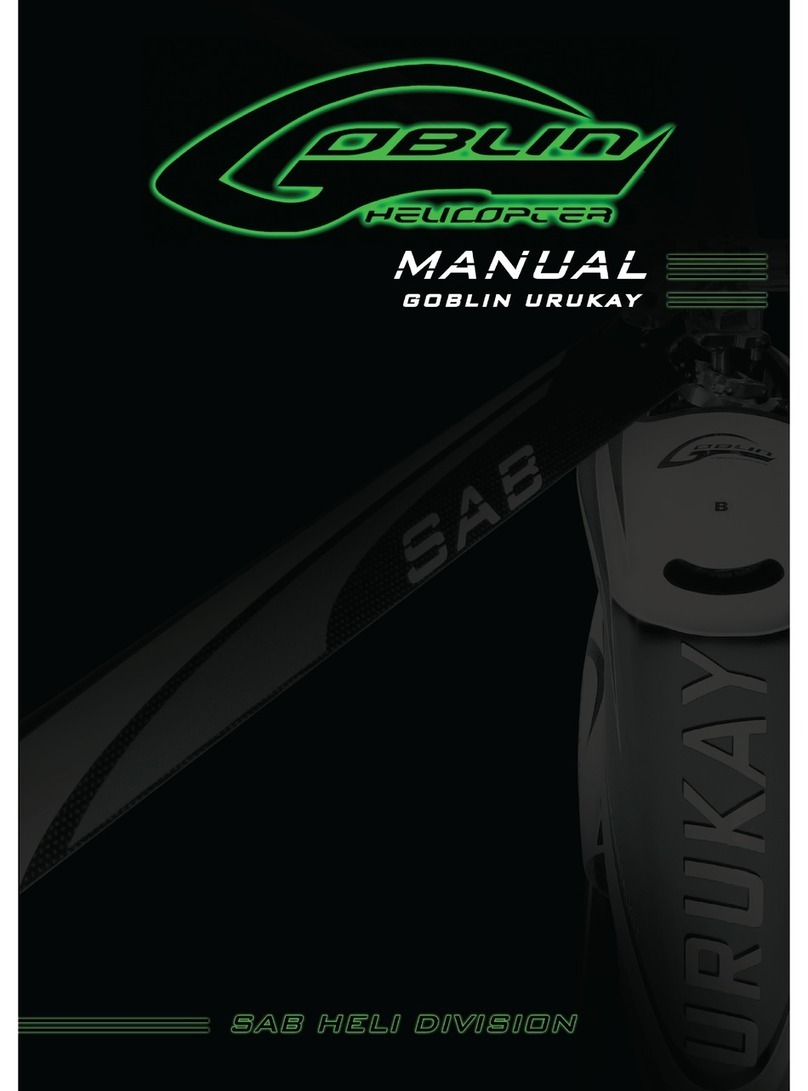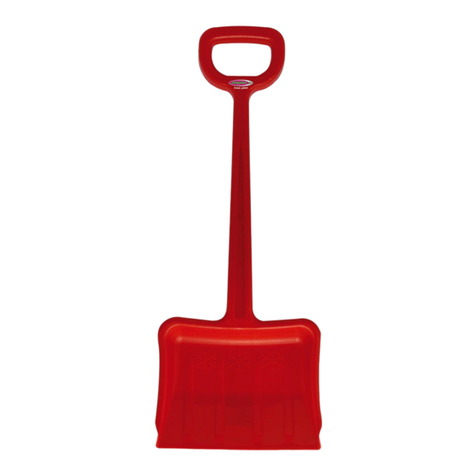Century UK RAZOR CX 2.4G Instruction Manual

ryffiw.:'tl
JrP'-u Century UK
21tL\7AA DGXA"4@
User Handbook
n
*-- :',-*.
Specifications:
Main Rotor Dia. A:480 mm
Tail Rotor Dia" B :480 mm
Overall Length: 600 mm
All-up Weight: 4609 (Battery included)
Transmitter: CUK-2401
DriveMotor: 2"3805H
Battery: 11.'1V 1500mAh Li-Po
Gyro: Built-in
Servo: weight: 8.49
speed: 0.'l 2sec/60" (4.8V)
torque:'1 .4kgf.cm(4.8V)
dimension : 22.5X1 1 .5X24mm
Features:
1)CNC-Metal full option rotor head with super stable coaxicial design. Highly efficient and easierto fly than a
traditional model helicopter.
2) Utilizing the new 2.4GHZ technology which uses precise code pairing allowing multiple models to be flown
at the same time.
3) Fitted with the high spec 4-in-'1 receiver with built in ESC, Rate adjustment and stabilizing Gyro.
4) Two high performance 3805H motors powered by a 11.1v high capacity Li-po battery giving up to 10 minutes
flight time.
5) Construction is both light and strong utilising state of the art materials giving a prompt response and accurate
control.


Contents
6.3 Sketch map of channel
connection of receiver
6.4 Function of ESC "-"""" I
I
6.5 Connection method of ESC ...........
6.6 Matters needing attention
07. lnstruction and attention
of servo
7.1 Specification and function of
Servo's
.......9
(7) Away from heat source '..
2.3 Attention before flight ---"----------------- 2
03. Definition of Helicopter Orientation .............-...... 3
04. Standard equipments .'...'...'........., 3
05. lnstruction and attention of
CUK-}4OL transmitter """"" 4
5.1 Features of transmitter ...................., 4
5.2 Function of CUK-240'1... .................-...4
5.2.1 ldentification and function
offunctional Keys """"" 4
7.2.3 Matters needing attention.... ...---.10
08. lnstruction and attention of
CUK005 balance charger 't0
5.2.2 ldentification of DIP switches
8.1 Parameters of CUK005 balance charger ....................... 1 0
8.2 Features of CUK005 balance charger..........................., 1 0
8.3 lnstruction of CUK005 balance charger.......................... 1 1
8.4 Operation s1eps............... ...................... 11
8.5 Charging statuses corresponding
to LED """""""""""""" I I
5.2.3 Function status of DIP switches.......................... 6
5.2.4 Default settings of DIP switches .....................'... 6
5.3 lnstruction and aftention
of transmitter 7
5.3.1 Battery mounting ........'...."........'7
5.3.2 Matters needing attention................................. 7
5.3.3 Code pairing and its attention .......""..'....----....'.7
06. lnstruction and attention of .................................. g
Receiver
8.6 Matters needing aftention 11
12
8.7 Maintenance of battery pack........'.......
6.1 Features of receiver "."' 8
8
6.2 Function of receiver

9.3 CG balance .............., 't 3
9.4.1 Turn on the power ..'........ 13
9.4.2 Matters needing attention .'.......... 13
9.4.3 Troubleshoot of receiver LED
keeping on flashing after power """"""""""""""' 1 3
cable connected
9.5 Adjustment before flight """""""""""'14
9.5.1 Adjustment of swashplate
9.6 Adjustment of Main Rotor Blade
15
9.6.1 lnspection of Main Rotor Blade """""""""""""'15
9.6.2 Adjustment of Main Rotor Blade """"""""""""' 15
11. Flight over ........ ..........15
Appendix 1 - flight control............................"""........... 16
Appendix 2 -trimming the flight'.................""'.............. 17
actions
Appendix 3 - flight practice """".......... 18
1 Flight practice for the beginner """"""""""""""""""" 18
1.1 Matters needing attention """""""'' 18
1.2 Steps 18
2 Advanced practice """"" 19
2. 1 practice of takeoff and landing "....................".-----.. 19
2.2 practice of square flight
2.3 Practice of circular flight
....19
...19

tx tl
LTD-!
01
the use of products, as we have no
less than 14 years old.
$=
b6"
,GEXI!'FT
z
BAZ@B@)(e"re
Dear customer:
Thank you for purchasing this Century UK CX 2.4G. ln order to promptly and safely master the operations of
this helicopter, please carefully read the user handbook, and then save it in a safe place for future consultation
and reference.
Razor CX2.4Gtakes advantage of reinforced main frame and2.4cspread spectrum technology of 3-in-1 combination
of receiving circuit, gyro and CCPM mixing. lt features vigorous power, stable flight, prompt response, and strong
anti-jamming capacity.
2.1 Statement
(1) This product is not a toy. lt is a piece of complicated equipment which harmoniously integrates together
engineering materials, mechanics, electronics, aerodynamic and high frequency radio. Correct installation
and adjustment are a must in order to avoid accidents taking place. The owner should operate in a safe
manner. lmproper operation may result in serious property damage or bodlly injury, even death.
(2) We accept no liability for damage and consequent damage arising from
control over the way they are installed, used and operated.
(3) This product is suitable for RC-helicopter-experienced people aged not
(1) Far away from obstacle and people
RC helicopter in flight is uncertain of flight speed and status, which potential
risk exists in. when flying, please keep your RC helicopter far away from
people, high buildings, high-tension line, etc, and avoid operating in rain,
storms, thunder and lightening.
(2) Away from humidity environment
RC helicopter should be kept away from humidity and vapor because it is
composed of complicated precise electronic elements and mechanic parts.
(3) Proper operation
Please use original spare parts to upgrade, modify or maintain your helicopter
in order to assure its safety. Please operate your helicopter within the range
of functions permitted. lt is forbidden to use out of the safety laws or regulations.
(4) Avoid flying alone
At the beginning of studying radio-control flight skills, there exist some difficulties.
Please avoid your flying alone, and should invite experienced pilots to guide
you (it is one of the effective manners to practice via PC simulator and/ or
skilled pilots' guidance).
(4) The flight field should be legally approved by the local government. We accept no liability for any safety duties
arising from operations, uses, or controls as soon as the products are sold.
(5) We consign our distributors to offer technical support and service after sale. Please contact the local distributors
for problem solutions caused by usage, operation, maintenance, etc.
2.2 Salely needin g attention
RC helicopter is a high risk hobby, whose flight should be kept far away from other people. Misassembled or
broken main frame, defective electronic equipment, and/ or strangeness to radio system will lead to unforeseen
accidents such as bodily injury or property damage. The pilot MUST pay attention to the flight safety and
UNDERSTAND his responsibility for accidents caused by his carelessness.
trr* r r.&'*al tF;Jt IJI ll.ll _ ** *

- Gilrf'EYrr 4
4LrD-A
BAz@R@)(A"a"@
.t?t,tr.&&&t;
(5) Safety operation
Please fly your helicopter according to your body status and flight
skills. Fatigue, listlessness and miss-operation will increase the
possibilities of accidental hazard.
1'O; nway from highly spinning parts
Please keep pilot, people and object away from the spinning blades
of both main rotor and tail rotor.
(7) Away from heat source
RC helicopter is made from metal, fiber, plastic and electronic elements,
etc. Please keep away from heat, sunshine in order to avoid distortion,
even damage, caused by high temperature.
&Y
2.3 Attention before flight
(1 ) Connect the power cable of the flight battery within 10 seconds of the transmitter being switched on, during
this period the transmitter battery indicator will be flashing indicating that it is trying to pair up with the model.
(2) lf you fail to connect the flight battery within 10 seconds after the transmitter is switched on then make sure
that it is disconnected and then turn of the transmitter and repeat step one.
(3) Ensure both the throttle stick and the throttle trim of your transmitter stay at the lowest positions before
operation.
(4) Please strictly obey the order of turn-on and turn-off before operation. When starting your flight, please turn
on your transmitter first, and connect the power cable of your helicopter last.
When finishing your flight, please disconnect the power cable of your helicopter first, and turn off your
transmitter last.
(5) An upset in the order of connection may cause your helicopter to loose control. Please cultivate a correct
habit of turn-on and turn-off.
(6) Ensure the directions and actions which servos execute transmitter commands are correct and smooth,
respectively. Using a broken servo will result in unforeseen dangers.
(7) Check there are no missing or loose screws and nuts, no unassembled or damaged parts. Carefully check
the main blades have no defects, especially the position close to the main blade connector. Broken or
unassembled parts will have an effect on the flight performance, and will cause unforeseen potential dangers.
(8) Check all the connections between ball linkage and ball. Loose linkages and balls should be changed. Loose
connection between linkage and ball will have an effect on the flight performance, even lose control.
(9) Assure there are solid connections between the power cables of battery pack and motors. Continuous vibrations
in flight may loosen the battery tie-ins.
(10) Check the model over for loose screws etc. before every flight.

GEf,TUTTIT ,/
a' - LD- -1
U
BAZ@B@)(P.4@
We define the orientation of helicopter in order not to cause confusion in the following descriptions. That is to
say, the tail boom of helicopter is facing the pilot (tail in), and its head facing forward (front of pilot). The left
hand of pilot is the left side of helicopter, the right hand of pilot is the right side of helicopter. lts head is to the
front and its tail boom is to the back. The direction in which main body of helicopter is facing is up, and its skids
are facing down.
i
down
A Helicopter
A Li-polymer battery pack
A Wall adapter /Power supply
L CUK-2401 transmitter
rF-:-
A Tool kit
A CUK005 balance charger
f
EI GFa-
ffi=
User handbook

- eEirfl.rBtYlg( {
1----- tto- i
RAZ@R@Xe"6!@
5.1 Features of transmitter
(1) CUK-2401 transmitter encoder applies 4-channel micro computer system and 2.4G spread spectrum technology,
which features automatic code pairing and lD assignment with prompter response, higher sensitivity and stronger
anti-jamming capacity.
(2) Technical data of CUK-2401
Output power Drain current Battery type and spec
(1OmW {50mA 1.5V' BAA dry cells ot 1.2V, 8 NiCd r9.6V 650mAh)
(3) On the reverse of transmitter there are a number of DIP switches, which may be used in conjunction with a
variety of different servos, to perform ascending, descending, forward, backward, leftward, rightward flights
and so on.
(4) lt is possible to mechanically switch between mode 1 and 2 .
5.2 Function of CUK-2401
5.2.1 ldentification and function of
functional Keys
Antenna
9. Power lndicator
7. Power Switch 8. Hook
1. Left Stick 2. Right Stick
5. Rudder Trim 3. Aileron Trim
4. Elevator Trim 6. Throttle Trim
1 1. SIM Jack
1 2. Charge Jack
13. Battery
Compartment

-- cHrrrtrl,( 4
ZLrD-A
mAz@R@xe"4@
t*.{,.' '-}.-t,, t'
::;;tmcu6g*gr:;;
iXfXrr{rys&ry(&, &*i
S/N ldentification Function
1Left Stick Mode 2 (throttle stick at left hand): forward and backward moving the left stick
makes your helicopter ascending and descending, respectively; leftward and
rightward shaking the left stick turns your helicopter leftward and rightward,
respectively.
2Right Stick Mode 2 (throttle stick at left hand): forward and backward moving the right stick
flies your helicopter forward and backward, respectively; leftward and rightward
shaking the right stick turns your helicopter leftward and rightward, respectively.
3Aileron Trim Aileron trim subsidiary adjusts left- and righlspinning of tail blades.
4Elevator Trim Elevator trim subsidiary adjusts helicopter forward and backward
5Rudder Trim Rudder trim subsidiary adjusts left- and right-turning.
6Throttle Trim Throttle trim subsidiary adjusts helicopter ascending and descending.
7Power Switch Pushing up switches on and pulling down switches off the power of transmitter.
IHook Neck strap releases the tension of your hands from holding transmitter.
IPower lndicator
Indicates the current battery volume status of transmitter:
1) Green LED on: battery is saturated and normal flight is permitted;
2) Green LED off but yellow LED on: battery is short of power. Please stop flying
as soon as possible;
3) Yellow LED off but red LED on: battery is seriously short of power. Please stop
flying immediately.
10 Antenna Transmits wireless signal.
11 Charge Jack
Can be used to charge the transmitter battery pack at charge current 50mA,
voltage < 12V.
Notice:
'l ) lt is forbidden to charge non rechargeable battery pack via this charge jack;
2) lt is forbidden to use the accompanied wall adapter as a DC power supply
please see section 4 - "standard equipment".
12 SIM Jack Connects to the data cable of computer simulator.
13 Battery
Compartment Mounts 1.5V X 8AA dry cells battery or '1.2V X I NiCd (9.6V 650mAh). Please
notice the polarities of the cells while mounting.
14 Battery Cover When changing cells, please lightly press down the center of battery cover and
then pull down the cover to open.

cGllrt tYtx {
?=L'D-ti
<-/
BAZ@R@)(e"4B
5.2.2 ldentification of DIP switches E
::::XWL;;:::::
rEL
.t.':1p-*1'.1::
' ttaitt
i;::Srytt::
1. Elevator
3. Throttle
5.2.3 Function status of DIP switches
5.2. 4 Default settings of DIP switches
Note: ON position is marked "ON", and the reverse position of ON is default ,,OFF,,.
DIP S/N 2 3 45-12
Status OFF OFF OFF OFF NOT USED
2. Aileron
4. Rudder
5. Not used
' i.. -,!*,rt r
S/N Function ON OFF
1Elevator Reverse Normal
2Aileron Reverse Normal
3Throttle Reverse Normal
4Rudder Reverse Normal
5NOT USED

,05
lnstruction
and attention
of CUK-2401
tra.nsr-nittel
GENil'RIIYI.I( I
4'"o-a
<__/
RAZ@R@Xe"4@
5.3 lnstruction and attention of transmitter
5.3.1 Battery mounting
Lightly press down the center
of battery cover, and remove
along the arrow direction.
Take out the battery holder
and pull out the JST jack. According to the correct polarities,
mount '1 .5V X 8AA dry cells or
I .2v x 8 NiCd (9.6V 650mAh)
+
7
+
A
\t
lnseft the JST jack shown as the
picture. Notice: the flat plain of
the JST should be upward and
the concave downward.
Mount the battery holder according
to the correct direction. Mount the battery cover according
to the arrow direction.
+
Mounting is finished.
5.3.2 Matters needing attention
Ensure saturated power and correct polarity of transmitter battery pack and solid buckle connection to avoid shortage
of battery power or sudden power off.
5.3.3 Code pairing and its attention
(1) Put the flight mode switch in "N" position.
(2) Keep both the throttle stick and throttle trim at the lowest position. Turn on the transmitter. The power indicator
in transmitter quickly flashes (it is in the process of code pairing. DON'T move any sticks or trims).
(3) And then connect the power cable of your helicopter. The receiver LED becomes solid lighting afier 1-3
seconds, simultaneously move once the right stick of transmitter leftward or rightward (note: DON'T move the
throttle stick forward or backward in order to avoid blades sudden spinning at high speed), the power indicator
of transmitter stops flashing and resumes the status of power indication. lt means the code pairing is successfully
finished and you can operate your helicopter. in general, the code pairing time is less than 10 seconds.

--- ca?urrlx 4
zLrD-I
BAZ@ts@)(e.4@
(4) Automatic scanning method is utilized. During the process of code pairing, occasionally failure of code pairing
will happen because lD matching fails during scanning. Please disconnect power cable of your helicopter
and turn off transmitter in sequence. Then turn on transmitter and connect the power cable in order within
1 0 seconds and re-enter the status of code pairing.
(5) lt is forbidden to allow many pilots to make code pairing at the same time.
(6) After the code pairing is successfully finished, many pilots are allowed to fly at the same time and in the same
field.
6.1 Features of receiver
(1) Receiver adopts 2.4G spread spectrum technology with the functions of automatic scanning, code pairing
and LED receiving indication.
(2) 4-channel signal output makes fine actions and powerful functions available.
(3) Servo extent and gyro sensitivity offer fine and customized adjustments to relevantly meet the habits of your
operation.
6.2 Function of receiver
6.3 Adjustment of receiver
(1) Status of LED indicator of receiver: quick flash means the signal is being received; solid lighting means the
signal has been received; slow flash means no signal has been received.
(2) Servo extent knob (EXTENT): CW rotating toward (+) increases the servo travel and CCW rotating toward
(-) decreases the travel.
(3) Gyro tuning knob: CW rotating toward (+) increases the servo travel and CCW rotating toward (-) decreases
the travel.
S/N Name for short Full name Function
1ELEV Elevator servo Connects to the elevator servo and receives the control signal of
elevator servo.
2AILE Aileron servo Connects to the aileron servo and receives the control signal o,
aileron servo.
3ESC ESC signal wire Connects to the ESC and receives the signal of ESC (Electronic
Speed Controller).
4LED LED Displays the status of receiving signal.
5SENSITIVE Gyro sensitivity
adiustment knod Adjusts the gyro sensitivity and changes the flight status.
6EXTENT Servo extent knob Servo extent knob is used to set up the servo travel.

- GCX,UFYIT( 4
<---- Lao-.\
<--/
BAZ@BG)(P,"re
6.4 Function of ESC
Electronic Speed Controller (ESC), mainly used in EP helicopter as a drive output device, is an electronic control
circuit for the revolution speed and CW- and CCW-rotation of the motor. lt will magnify the proportional signal it
receives into voltage and current that can be directly exploited by the motor, the advantages of which, compared
with the traditional mechanical speed controller, include compact dimension, long longevity, high efficiency and
high output power.
6.5 Connection method of ESC
t
t
UP motor cable
*-
Low motor cable
Power cable
Flashlight power cable
6.6 Matters needing attention
(1) All the signal wires should be connected in a correct way. Misconnection will result in failure to receive signal,
even damage to receiver and motor.
(2) Please use the special adjsutment pen to adjust all the knobs in order to avoid damage.
7,1 Specification and function of servo
7.1.1 Specification of servo
Weight Voltage Torque Speed Dimension
8.49 4.8-6V 1.4kgf.cm 0.12sec/60" 22.5x11.5x24mm
7.1.2 Basic function of servo
Servo is a kind of electromechanical device that converts the signal from the receiver into mechanical movement,
the function of which mainly aims at transforming the electronic signal into relevant mechanical movement, by
means of which the control for its direction and speed can be achieved.
s/N Name for short Full name Funclion
1LOW MOT. Front motor Connects to the front motor.
2UP MOT. Back motor Connects to the back motor.
3BATT Power cable Connects to the battery.
4Flashlight power cable Connects to the bFlashlight power cable
5ESC signal wire Connects to the ESC and receives the signal of ESC
(Electronic Speed Controller).

-- cHruFrrt( 4
zLrD--c
BAZ@B@)(e"4@
7.2 Connection and adjustment of servo
7.2.1 Connection of servo
ELEV(L)
ArLE(R)
s/N Receiver
terminal Connection method Wire direction
4AILE Connects to the plug of aileron servo signal wire The white wire is facing front
5ELEV Connects to the plug of elevator servo signal wire The white wire is facing front
7.2.2 Adjustment of servo
Before departure from Factory, all the servos have been given correct adjustment and are locked at the initiation
status. ln general, we don't need make any adjustment.
7.2,3 Matters needing attention
(1)All the plugs should be correctly connected. Otherwise wrong connection will make servos not function or
lead to the direction which is different from the pre-set.
(2).Before departure from Factory, all the servos have been given correct adjustment and are locked at the initiation
status. Please ensure that the travels of servo bell cranks should be within the range of its fixed extent during
replacement, installation, and adjustment of servo linkages.
8.1 Parameters of CUK005 balance charger:
lnput voltage lnput current Output current Dimension Weight
DC15-18V 1000mA (800mA 62.5x47x20.Bmm 469
8.2 Features of GA005 balance charger
(1) CUK005 utilizes microcomputer chips to monitor and control over the whole charging process in a balanced
way with LED indicating light to display the charging status at real time.
(2) Connects to an input power supply (DC 15-18V 1000 mA).
(3) lt is suitable for 2-3S (7.4V1 11.1V) Li-ion or Li-polymer battery pack.
(4) Automatically detects 2-3S Lithium battery pack. CUK005 will automatically charge when it finds the voltage
of anyone cell among the LiPo pack is excessively low. At the same time LED displays as charging status
(flash in red). The voltage of anyone cell LiPo is controlled at the level of 4.2 t 0.05V to ensure the maximum
voltage difference of single cell in the battery pack is less than 50 mV.

8.3 lnstruction of GUK005 balance charger
Charging jack for
7.4V battery pack
Charging jack for
1 1.1V battery pack
8.4 Operation steps
\/
Plug the wall adapter into the mains
power supply. lts output end connects
to CUK005. Then its LED is lighting
in solid red.
tltjx k *r t
' '-:and;;::.:iii;:;
:::ia{mx(irmx*x*
' of cr,[forEi -
'- batanixi----
- "cbargdr----
3
t
x
rs
lnsert the balanced pin of LiPo
battery pack into CUK005.
lnput jack
During charging, Red LED is
mntinuously fl ashing. lf saturated,
Red LED becomes solid green
lighting.
8.5 Charging statuses corresponding to LED
steps Operation LED Status Charging status
1
lnsert the wall adapter into the mains
power supply, and then its output is
connecting to CUK005. LED is in red solid Iighting Power on
2Step 1 + connect the battery pack to
CUKOO5
LED is flashing in red Charging
LED becomes from red to
solid oreen. Saturated
8.6 Matters needing attention
(1) During charging, CUK005 should be put in dry and ventilated place and be far away from heat sources and
inflammable and explosive substances.
(2) CUK005 is only used to charging a 25 or 35 Li-ion or Li-polymer battery pack. lt is forbidden to simultaneously
charge two or more sets of battery packs. Either the charger or battery may be damaged.
- (eEil,rUFTtI( 4
< - LID''-U
RAZ@B@Xe"4e
Status LED
r- t,
.;XtmK:riii:t

- GEIIII'TYTI( 4
<---- Lae- \
C/
RAZ@R@Xe"re
(3) When charging, the battery pack should be removed from your helicopter. Never leave the charger unsupervised
during the process of charging in order to avoid risk of accidents.
(4) Never immediately charge your battery pack as soon as the flight is finished, or when its temperature doesn't
cool down. Otherwise the battery will take a risk in swelling, even a fire.
(5) Ensure the correctness of polarity before connecting the battery to charger.
(6) Avoid drop and violence during the process of charging. Drop and violence will result in internal short circuit
of the baftery.
(7) For the sake of safety, please use original charging equipment (wall adapter + CUK005 balance charger)
and battery pack. Please change new one in time when the old battery pack is becoming swollen due to
long time usage.
(B) lf it is retained in the charger for a long time after saturated, the baftery may automatically discharge. When
the charger detects that the voltage of individual cells is lower than the rated voltage, it will re-charge until
saturated. Frequently charging and discharging will shorten the lifetime of your battery pack.
8.7 Maintenance of baffery pack
(1) The battery pack should be put in dry and ventilated place. The storage temperature of the environment is
ranged from 18"C to 25'C.
(2) Please avoid frequent charging and excessive discharging the baftery pack in order to prolong its life cycle.
(3) lt is a must to maintain the battery pack before long-term storage. That is to charge the battery to the level
of 50-60% saturation.
(4) lf the storage term is over 'l month, it is advised to monthly check the voltage of every cell of the battery
pack. The voltage of every cell should be not less than 3V. Otherwise, please refer to the above article (3).
(5) From the view point of protection, new battery pack should be motivated before usage. That is to charge
and discharge 3-5 times, but discharge is not less than the level of 70% saturation. This process will make
the battery lifetime longer and voltage more stable.
9.1 Flybar set assembly
'1. Let the location notch of flybar block aim at the flybar, and press the flybar block till the flybar reaches the
end of notch; lnsert one end of the flybar through hole 1 (Fig. 9-1 );
2. Let the location notch of flybar block aim at the inner location mast of flybar block sleeve, and press the flybar
block along the inner location mast into the sleeve (Fig. 9-2);
3. Counterclockwise rotate 90' the flybar block sleeve (Fig. 9-2), let the hole 1 of flybar block sleeve aim at the
hook of flybar, and then push the flybar block set outside and make the hook completely insert into the hole 2
(Fig. e-3).
t
Note: the flybar set will be thrown off at high speed
in flying when it is mounted improperly. A serious
damage to people or property may be taken place.
Flybar block sleeve
I
Location notch
Fig.9-2 -=,.--. 7>\ \
_ -4=1 ( ((F"o )
---r_--L\Y/ ./
Fig.9-3 .--f-. _
-
\.o
\ \_7
+

-- GHrrrBru( //
<---= LTD-a/
<J
BAZ@B@>(e"6r@
9.2 lnstallation of battery pack
Open the battery compartment, lnstall the baftery pack
into the battery compartment along the arrow direction. Battery pack
location
9.3 CG balance. Put your helicopter in a horizontal ground and make the flybar vertical to the tail truss of your
helicopter. Lift your helicopter using your index fingers to support the two sides of flybar, and check the
balance. The tail truss should be level with the ground. lf it is not, move the battery pack backwards or
forwards to balance. Always check the Center of Gravity (CG) with the battery pack and canopy installed.
Sketch map of battery installation
9.4 Turn on the power
9.4.1 Turn on the power
t
I
Sketch map of battery installation
1 . Take off the canopy, and install the battery
pack in the battery compartment.
Pull down the throttle stick and throttle trim
of transmitter to the lowest position, and
then move the elevator trim, aileron trim,
and rudder trim at the neutral positions,
respectively.
4. Connect the power cable of helicopter to
receive signal from transmitter.
3. Turn on the power of transmitter.

GEtrt tYlx I
<___/
BAZ@B@)(e"4@
9.4.2 Matters needing attention
(1) When operating, please obey the principle of "turn on transmitter first, and connect the power cable of
helicopter last". Connect the power cable of helicopter in 10 seconds after the transmitter turned on. The
red LED in receiver begins to flash. lf the red LED becomes solid lighting and the mechanic beeps of servos
initialization are heard, the receiver has received the signal from transmifter. The code pairing is successfully
finished.
(2) lf failed to connect the power cable of helicopter in 10 seconds after transmitter is turned on, please turn off
the transmitter and repeat the step (1).
9.4.3 Troubleshoot of receiver LED keeping on flashing after power cable connected
Possible causes Solutions
Failure to code pairing. Re-turn on transmitter and re-connect the power
cable of helicopter.
The throitle trim and throttle stick of transmitter
are not at the lowest position. Pull down the throttle trim and throttle stick to the
lowest position and re-pair code.
The electricity of transmitter is short or used up. Change new battery of transmitter, and pair code
again.
The electricity of helicopter is short or used up Change new battery pack of helicopter, and pair code
again.
No function in receiver or transmitter. Change receiver or transmitter, and pair code again.
9.5 Adjustment before flight
Warning: Disconnect the power cable of main motor before adjustment for the sake of pilot's safety.
Matters needing attention: all the original equipments have been adjusted well before departure from factory.
ln general, it is unnecessary to make adjustment. Due to bump caused in long-distance transportation, some
joint parts may be loose, even broken off. For the sake of safety, please strictly refer to the section 2.3 - "attention
before flight" and check throughout your helicopter.
9.5.1 Adjustment of swashplate
lnspection of swashplate
Warning: Disconnect the power cable of main motor before adjustment for the sake of pilot's safety.
Put your helicopter in a spacious horizontal ground. Move the throttle stick and throttle trim of transmitter to the
lowest position, and move the elevator trim, aileron trim and rudder trim at the neutral position, respectively.
Turn on the transmitter first and then connect the power cable of helicopter. After the LED in the receiver stops
flashing while mechanic beeps of servos initiation heard, the signal has been received. Then check whether
the bottom level of swashplate is parallel to the longitudinal axis of the helicopter - the extension line of tail boom.
Check also that the bottom level of swashplate is parallel to the lateral axis of the helicopter.
Parallel
Bottom level of
_ _lyggltpl{e_ _ _
Estension line
_ _9lt_all_b_o_qr!- _
Swashplate adjustment.
lf the swashplate is not horizontal, you can adjust through the following two steps: @ servo and sevo bellcrank
adjustment. Loosen the servo bellcrank screws and the servo bellcrank and then reconnect the power of the helicopter.
.:.
,.4
r!-
,XFllix::ii;
,l,:& =liixixii
-0g'-
Srsps d
ffigtt "
:::
:t"
iY*
:xx

t
t
t
t
GEf,TUFYI,( /,
<--- LID-.\
<-/
BAZ@B@)(e"4@
Adjust the servo bellcrank to horizontal level after the reposition of the elevator and aileron servos, and then tighten
the screws. O Servo linkage rod adjustment. Adjust the length of the servo linkage rod to make the swashplate
horizontal.
9.6 Adjustment of Main rotor blade
9.6.1 Inspection of Main rotor blade
(1 ) lnspect whether the cross recessed pan head screw is too loose. lf the cross recessed pan head screw is
loose, the helicopter may vibrate during flight.
(2 ) lnspect whether the left and right main rotor blades are in line. lf the left and right main rotor blades are not
in line, the helicopter will vibrate during flight.
9.6.2 Adjustment of Main rotor blade
(1 ) lf the cross recessed pan head screw of the main rotor
blade is too loose, tighten the cross recessed pan head
screw.
(2) lf the left and right main rotor blades are not in line, hold
the ends of the main rotor blades and stretch the blades
in line.
Note: when inspecting the main rotor blades, please enter
the Adjustment Mode.
Below are the detailed adjustment steps:
1. Put the Throftle Stick at the top position.
2. Turn on the transmifter power, plug in your helicopter power, and begin to automatically match the pair code.
3. Enter the Adjustment Mode as well as the pairing code is finished. After the adjustment is finished in the
Adjustment Mode, please turn off the power of your transmitter and helicopter, and then re-pair code (it is
unnecessary to put the Throttle Stick at the top position at this step). Your helicopter is ready to fly now.
****** ******
Steering
linkage
Fixing
screw
Step 1: disconnect the power
cable of helicopter. Step 2: turn off the transmitter. Step 3: take off the battery pack.

|eErrrfrErltt ,,
<---a- LID-A
<__/
BAZ@R@)(e.4@
Mode 2 (throttle stick at left hand)
2. When moving the throttle stick up or down, the
helicopter accordingly flies up or down.
4. When moving elevator stick up or down, the
helicopter according flies foruvard or backward.
1. When moving the aileron stick left or right, the
helicopter accordingly flies left or right.
3. When moving the rudder stick left or right, the
head of helicopter accordingly flies left or right.
1. Adjust the rudder trim
Mode 2
Right
Move the rudder trim left if the head of helicopter flies rjght during take off; otherwise move the rudder trim left'
2. Adjust the elevator trim
Move the elevator trim down if the helicopter flies down during takeoff; otherwise move it up.
3. Adjust the aileron trim
Mode 2
c+Right
KKIIIIXX.
;x:w-;3.r;
'-InI-
**,WI,itr,,,
x'xiEL';:.i.1
I l:-:!--J----I
re&ff{gl!wx{*:i:i
rx,$rmr&€ilrrcttri.
Move the aileron trim right if the helicopter flies left during takeoff; otherwise move it left.
Table of contents
Other Century UK Toy manuals
Popular Toy manuals by other brands
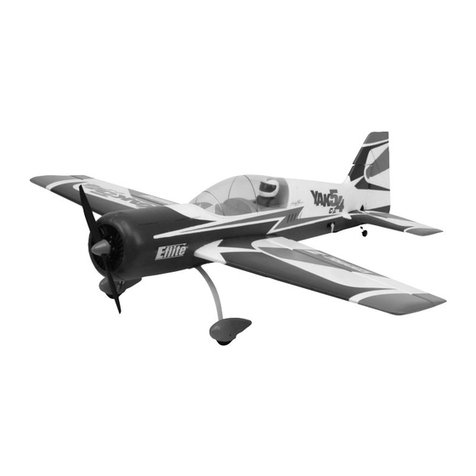
E-FLITE
E-FLITE CARBON-Z YAK 54 instruction manual

Dynam
Dynam Vortex V2 dy8906 instruction manual
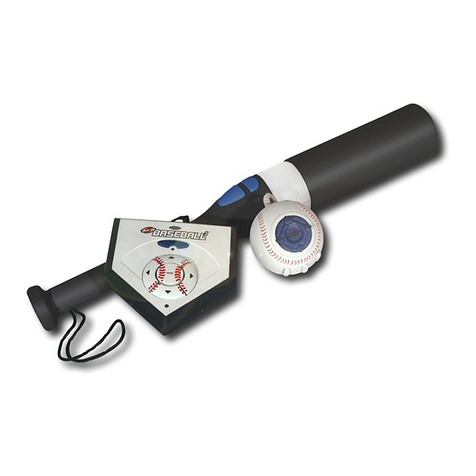
Radica Games
Radica Games 74022 instruction manual
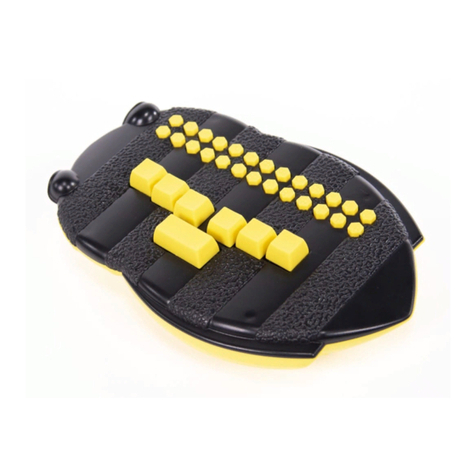
APH
APH BrailleBuzz 1-03935-00 Getting started

Savage Light
Savage Light F-106 DELTA DART Construction guide

Fisher-Price
Fisher-Price COLOR PIXTER G6512 owner's manual



